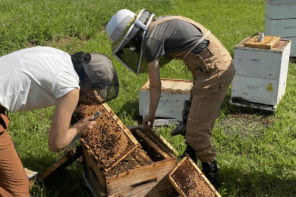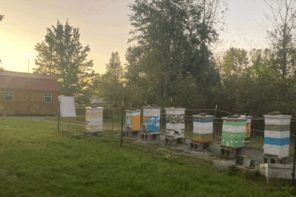Leonard Riepenhoff
 Full frame solar ovens can extract six to eight pounds of honey (two medium frames full of capped honey) or several frames partially full of capped honey, and you can bottle the honey in the same day when the temperature is 80 degrees or warmer and the sun is shining on the solar oven. A reflector will be helpful on cooler days. A piece of shiny aluminum foil, a mirror or shiny piece of metal reflecting behind the oven will work (see photo). I suggest, in order to avoid spillage, the honey container below is larger than necessary to hold the honey and wax.
Full frame solar ovens can extract six to eight pounds of honey (two medium frames full of capped honey) or several frames partially full of capped honey, and you can bottle the honey in the same day when the temperature is 80 degrees or warmer and the sun is shining on the solar oven. A reflector will be helpful on cooler days. A piece of shiny aluminum foil, a mirror or shiny piece of metal reflecting behind the oven will work (see photo). I suggest, in order to avoid spillage, the honey container below is larger than necessary to hold the honey and wax.
Solar ovens eliminate the use of any mechanical or electric devices. Uncapping is not necessary. The frames with capped honey are placed in a super and then set on top of the solar oven, after removing the top lens from the solar oven, and repositioning it on top of the super with the frames with capped honey. As the honey warms it liquefies and drips down into the container below where it cools. When the temperature in the oven gets warmer, the wax melts and it runs down into the same container with the honey and floats on top and solidifies when it cools. Then the wax is easily removed for other projects such as making candles etc. The honey can then be poured into containers. The frames may then be replaced in a honey super without any further care. Caution, on a hot day the plastic foundation frames should be removed soon after they are empty. Leaving them in too long may warp the plastic foundations.
I use a foundationless frame by altering the top bar of a wedge top bar frame, see photo of different ways to alter the top bar that work. I rub the bottom of the protruding bar with bee’s wax prior to installing the frame in a honey super. Installing foundationless frames between frames with a plastic foundation or between drawn frames in a honey super every other frame has worked well for me. I use wax foundations in my brooder supers, not in my honey supers. True this isn’t the most efficient way to get maximum honey, as the bees consume about six to eight pounds of honey for each pound of wax built, however there is less than a pound of wax in 10 medium frames.

True, the bees must then rebuild the wax combs; however young bees about eight to 14 days old produce wax whether they want to or not and look for a useful place to use it. Finding a place helps prevent swarming and avoids wax deposits where unneeded. To see more pictures, visit “CraigsList”/ honey extractors.
Using a full frame solar oven avoids using a hand crank or electric honey extractor and reduces the cleanup time dramatically. The average colony produces about 30 pounds of honey annually, more than enough for most needs.
Using foundationless frames also provides you with an easy way to package comb honey. I purchase small plastic containers from the Dollar store, they come with lids and have 10 in a package, just a nice size to sell or give to friends.
If you built the dual pane inner cover shown in the November 2021 Bee Culture issue on page 80, some of those parts can be used with your solar oven.
This is a hobby beekeepers dream come true.
Leonard Riepenhoff
In the apiary division at the Sonoma County Harvest Fair in Santa Rosa, Ca., Leonard’s honey won the “best of show” trophy three years in a row.









